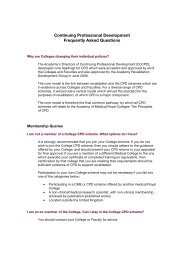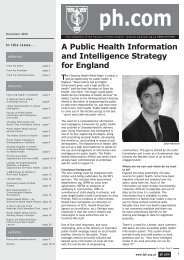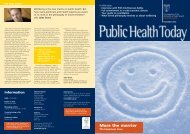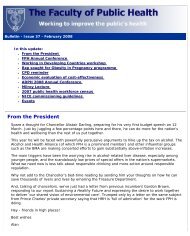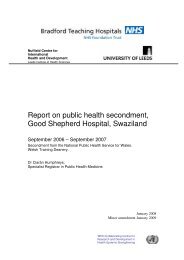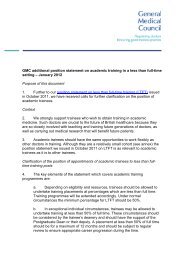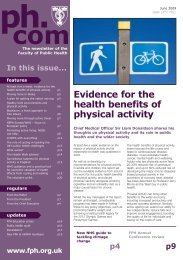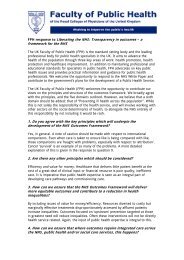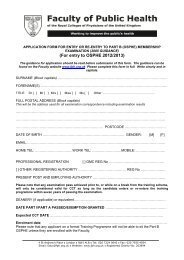A Chronology of State Medicine, Public Health, Welfare and Related ...
A Chronology of State Medicine, Public Health, Welfare and Related ...
A Chronology of State Medicine, Public Health, Welfare and Related ...
You also want an ePaper? Increase the reach of your titles
YUMPU automatically turns print PDFs into web optimized ePapers that Google loves.
Buckinghamshire. Florence Nightingale, in a letter to her nephew, Sir Frederick Verney<br />
(chairman <strong>of</strong> the North Buckinghamshire Technical Education Committee) outlined her ideas<br />
for health missionaries who would "take health into the home ... It seems hardly necessary to<br />
contrast sick nursing with this. The needs <strong>of</strong> home health-bringing require different but not<br />
lower qualifications <strong>and</strong> are more varied ... She must create a new work <strong>and</strong> a new<br />
pr<strong>of</strong>ession." Two years later Florence Nightingale set out the role <strong>of</strong> health visitors as giving<br />
instruction in the sanitary conditions <strong>of</strong> the person, clothes <strong>and</strong> bedding, <strong>and</strong> the house; <strong>and</strong><br />
the management <strong>of</strong> the health <strong>of</strong> adults, women before <strong>and</strong> after confinements, infants <strong>and</strong><br />
children. See 1892.<br />
Dense fog in London from December 20th to 25th.<br />
"A History <strong>of</strong> Epidemics in Britain", by Charles Creighton (1847-1927, pathologist,<br />
researcher, medical writer <strong>and</strong> historian), published. The second volume was published in<br />
1894.<br />
Volume 1 <strong>of</strong> "Life <strong>and</strong> Labour <strong>of</strong> the People in London", by Charles Booth (1840-<br />
1916, shipowner <strong>and</strong> writer on social conditions), published. The last <strong>of</strong> the 17 volumes was<br />
published<br />
1891 Cont - 1893<br />
1891 cont in 1903. The volumes gave a very detailed account <strong>of</strong> poverty <strong>and</strong> ill-health in<br />
London at the turn <strong>of</strong> the century.<br />
1892 Shop Hours Act (55&56 Vict., c.62) repeated <strong>and</strong> strengthened the requirements <strong>of</strong> the<br />
1886 act about the employment <strong>of</strong> young persons in shops; <strong>and</strong> placed the responsibility for<br />
inspection on the councils <strong>of</strong> the counties <strong>and</strong> county boroughs. See 1911.<br />
Burgh Police Act (55&56 Vict., c.55) in addition to police matters, required all burghs<br />
to appoint medical <strong>of</strong>ficers <strong>of</strong> health <strong>and</strong> sanitary inspectors <strong>and</strong> laid down regulations<br />
regarding housing, sewerage, provision <strong>of</strong> water, dairies <strong>and</strong> slaughter houses.<br />
Report <strong>of</strong> the Select Committee <strong>of</strong> the House <strong>of</strong> Lords on Metropolitan Hospitals,<br />
(chairman, Lord S<strong>and</strong>hurst) considered that the voluntary hospitals were generally well run;<br />
criticised the London medical world for its wasteful rivalries, <strong>and</strong> the concentration <strong>of</strong><br />
facilities north <strong>of</strong> the Thames; <strong>and</strong> recommended the establishment <strong>of</strong> a central board to coordinate<br />
the management <strong>of</strong> hospitals in the capital. Henry Burdett (see 1883) had opposed<br />
the setting up <strong>of</strong> the Committee in 1890 arguing that "more cash <strong>and</strong> less criticism" was<br />
needed. See 1986.<br />
International Sanitary Convention on cholera adopted.<br />
Buckinghamshire County Council appointed the first whole-time health visitor (see<br />
1862 <strong>and</strong> 1891). See 1908.<br />
Diphtheria antitoxin isolated by Paul Ehrlich (1854-1915, German medical scientist).<br />
"Journal <strong>of</strong> <strong>State</strong> <strong>Medicine</strong>" first published by the British Institute <strong>of</strong> <strong>Public</strong> <strong>Health</strong> (see<br />
1886).<br />
First volume <strong>of</strong> "A Treatise on Hygiene <strong>and</strong> <strong>Public</strong> <strong>Health</strong>", by Sir Thomas Stevenson<br />
(1838-1908, public analyst <strong>and</strong> medical <strong>of</strong>ficer <strong>of</strong> health for St Pancras) <strong>and</strong> SF Murphy<br />
(1849-1923, later Sir Shirley, medical <strong>of</strong>ficer <strong>of</strong> health for the London County Council),<br />
published. The third <strong>and</strong> final volume was published in 1894.<br />
"The Hygiene, Diseases <strong>and</strong> Mortality <strong>of</strong> Occupations", by JT Arlidge (see 1868),<br />
published.<br />
1893 Isolation Hospitals Act (56&57 Vict., c.68) enabled provincial county councils to<br />
establish isolation hospitals. See 1901.



